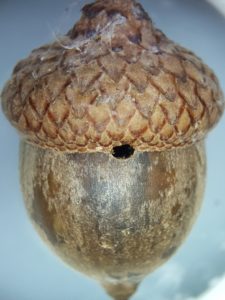
The round hole at the edge of the fallen acorn’s cap was created when an acorn weevil larva chewed its way out to find a place on the ground to overwinter.
In some areas of Oconto County, a large percentage of the acorns on northern red oaks dropped early. Most of those acorns were infested with acorn weevil, although at the time they dropped they looked whole. After sitting for a few days, acorn weevil larvae started to emerge in hopes of burrowing into the soil to find a place to spend the winter.
Adult acorn weevils have very long narrow snouts and feed on acorns that are still attached to the tree. They chew a small hole in the acorn, then lay an egg (or several eggs) in the hole. They then plug the hole with fecal pellets, camouflaging their work. The eggs hatch and larvae begin feeding within the acorns. In the fall, the acorn drops to the ground and the larvae chew their way out, after which they bore into the soil to spend the winter underground. There is a different species of acorn weevil that feeds on acorns that have already fallen.
Even though the acorns looked perfect when they dropped, the insects had already been at work on them. Floating acorns in water will allow you to sort out the ones that are damaged, even though you may not see damage on the outside.
Written by: Linda Williams, forest health specialist, Woodruff, (Linda.Williams@wisconsin.gov), 715-356-5211 x232.
